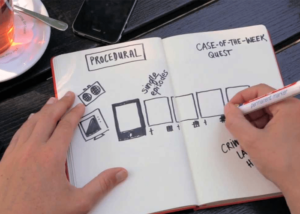Stories pay a pivotal role in marketing. They are crucial to bring our brands alive and crucial to create sharp Value Proposition. Great storytellers have many followers and are driving whole communities. In commercial jobs, the storytellers are the most successful dealmakers and Storytelling is recognized as the backbone of content marketing. Despite this all, in daily practice we hardly consider storytelling a professional expertise.
How often do you simple stand up and shake a story out of your sleeves, relying fully on your charisma and expertise.
Great if you do so, but then make sure you have a personal coach that act as a mirror who will honestly tell you after such an improvised performance that your key message was confusing?; that you rambled?; that the words you used were not understandable?; that you repetitively used the same words?
You can of course excite yourself with the superficial ‘great story’-pats on the back just after your performance. Better is to arrange for a coach that could act as a mirror, to get substantiated feedback to improve your performance. However, maybe my personal quick reference cards is a first step to start with.
Theatrical directions
Next to my marketing job, I have been a passionate director of theater plays. I have directed plays from Shakespeare, Brecht, Tennessee Williams and Ayckbourn, with a variety of amateur groups. Theater is the ultimate form of storytelling. It takes around 6 months off extensive rehearsal to ensure that the actors make a connection with the audience and are able to convey a convincing message. The director acts as a mirror to ensure that the actor’s intentions are fully “in sync” with the audience perceptions.
Off course our presentations in daily practice is not a play (at least I hope so), but some of the theatre principles I use on a daily basis to improve my storytelling skills.
Presentations and Story telling
One of the challenges I faced when working with the principles of storytelling (having a hero and a villain, having a problem and a solution, having a learning and a victory) is that it is not always easy to link it to simple presentations. Therefore over the years I created my “own rules” for creating presentations and stories, incorporating principles of storytelling, theatre, learning styles and marketing!
The reference Cards; 2P’s, 3 T’s and 3C’s.
For me creating a great presentation is a combination of PREPARTION and PERFORMANCE. In the Preparation phase, which is similar like the rehearsing phase in theatre, I use the 3T’s: Theme, Text and Technics. The Theme is the overriding Purpose and Feeling/ Emotion you want to create with your audience.
The TEXT; is like a Value Proposition, a sharp key message with a maximum of 3 persuaders. As we simply cannot remember more, Aristotle already proposed as “the famous rule of 3”.
The last part you consider during your preparation is the Technics. How big is your audience, is it one person or as many as 100? Also which form and instruments will you use?
These 3T’s allow you to envision your performance and mentally and physically practice.
THE PERFORMANCE
The ultimate proof point is the performance, here you want to ensure you have a CONNECTION with your audience, you want to ensure they stay CURIOUS during the whole presentation and that you CONVEY your message; the 3C’s of Performance.
To have impact with your story or presentation you need to ensure a connection to the heart and the brain. 70% of your audience will be visually oriented; therefore, you need to talk in pictures. The easiest is to use pictures but also your body language and words can stimulate the visualization. Can you imagine?
20- 30% of the audience is more focused on the exact meaning of words, they are auditory. For them there is huge difference between success and achievement; between motivation and stimulation; between inspiration and ideas. Choose your words carefully (already do this crafting your text during the preparation).
Great plays create curiosity in the first 5 minutes, a principle we can apply in our performance. Simply asking questions, defining a dot on the horizon. Simply indication that you will reveal some learnings later in your presentation. This curiosity is crucial for 2 purposes; 1 to trigger your audience mind and keep them alert secondly they will also link your text and arguments to the announced dot on the horizon. They get more into “checking modus” instead of “debate modus”.
The last C, is CONVEY, making sure that your message sticks, therefore you want to make sure that your audience brain works with the information presented. If you are able to let the audience conclude your conclusion themselves, you have a larger change that they will remember your story.
Being remembered
Marketing is about being remembered and so storytelling is an important capability to master. It requires thorough preparations and will prevent You from being remembered for a lucky shot or even worse a bad improvisations. I am sure my reference cards will help you with this.







